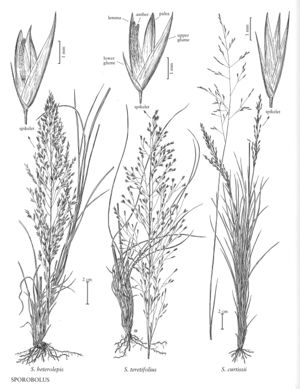Difference between revisions of "Sporobolus teretifolius"
FNA>Volume Importer |
imported>Volume Importer |
||
| (8 intermediate revisions by 2 users not shown) | |||
| Line 4: | Line 4: | ||
|publications= | |publications= | ||
|common_names=Wireleaf dropseed | |common_names=Wireleaf dropseed | ||
| + | |special_status={{Treatment/ID/Special_status | ||
| + | |code=E | ||
| + | |label=Endemic | ||
| + | }} | ||
|basionyms= | |basionyms= | ||
|synonyms= | |synonyms= | ||
| Line 17: | Line 21: | ||
-->{{Treatment/Body | -->{{Treatment/Body | ||
|distribution=N.C.;S.C.;Fla.;Ala.;Ga. | |distribution=N.C.;S.C.;Fla.;Ala.;Ga. | ||
| − | |discussion=<p>Sporobolus teretifolius is restricted to the south¬eastern United States, where it grows in wet to moist flatwoods and savannahs, at elevations of 10-150 m.</p> | + | |discussion=<p><i>Sporobolus teretifolius</i> is restricted to the south¬eastern United States, where it grows in wet to moist flatwoods and savannahs, at elevations of 10-150 m.</p> |
|tables= | |tables= | ||
|references= | |references= | ||
| Line 26: | Line 30: | ||
-->{{#Taxon: | -->{{#Taxon: | ||
name=Sporobolus teretifolius | name=Sporobolus teretifolius | ||
| − | |||
|authority=R.M. Harper | |authority=R.M. Harper | ||
|rank=species | |rank=species | ||
| Line 33: | Line 36: | ||
|basionyms= | |basionyms= | ||
|family=Poaceae | |family=Poaceae | ||
| + | |illustrator=Linda A. Vorobik;Hana Pazdírková | ||
| + | |illustration copyright=Utah State University | ||
|distribution=N.C.;S.C.;Fla.;Ala.;Ga. | |distribution=N.C.;S.C.;Fla.;Ala.;Ga. | ||
|reference=None | |reference=None | ||
|publication title= | |publication title= | ||
|publication year= | |publication year= | ||
| − | |special status= | + | |special status=Endemic |
| − | |source xml=https:// | + | |source xml=https://bitbucket.org/aafc-mbb/fna-data-curation/src/200273ad09963decb8fc72550212de541d86569d/coarse_grained_fna_xml/V25/V25_691.xml |
|subfamily=Poaceae subfam. Chloridoideae | |subfamily=Poaceae subfam. Chloridoideae | ||
|tribe=Poaceae tribe Cynodonteae | |tribe=Poaceae tribe Cynodonteae | ||
Latest revision as of 17:58, 11 May 2021
Plants perennial; cespitose, not rhizomatous. Culms (20)35-80(100) cm, wiry. Sheaths shiny and indurate basally, glabrous or appressed hairy elsewhere, hairs to 4 mm; ligules 0.2-0.4 mm; blades (10)25-54 cm long, 0.5-1.2 mm wide, terete or subterete at least basally, sometimes channeled for portions of their length, green to yellowish-green, senescing or turning tan in late fall, glabrous on both surfaces or the adaxial surface sparsely hairy basally, margins smooth. Panicles 10-26 cm long, 1-9 cm wide, open (contracted when immature), not diffuse, narrowly pyramidal to ovate; lower nodes with 1-2(3) branches; primary branches 1-8 cm, ascending or spreading to 40° from the rachis, not capillary, without spikelets on the lower 1/3; secondary branches spreading; pulvini hairy; pedicels 3-18 mm, longer than the spikelets, spreading, with scattered ascending hairs. Spikelets 4-5.6 mm, purplish-brown. Glumes unequal, linear-lanceolate, membranous; lower glumes 2-3.8 mm, 0.5-0.8 times as long as the upper glumes; upper glumes 4-5.6 mm, usually longer than the florets; lemmas 3.4-4.4 mm, ovate, membranous, glabrous, acute; paleas 3.3-4.4 mm, ovate, membranous, glabrous; anthers 1.5-2.6 mm, purplish. Fruits not seen. 2n = unknown.
Distribution
N.C., S.C., Fla., Ala., Ga.
Discussion
Sporobolus teretifolius is restricted to the south¬eastern United States, where it grows in wet to moist flatwoods and savannahs, at elevations of 10-150 m.
Selected References
None.
